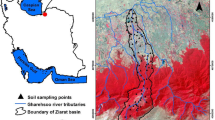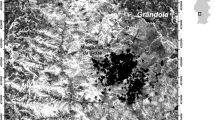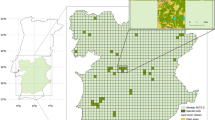Abstract
Identifying high-quality habitats across large areas is a central goal in biodiversity conservation. Remotely sensed data provide the opportunity to study different habitat characteristics (e.g., landscape topography, soil, vegetation cover, climatic factors) that are difficult to identify at high spatial and temporal resolution on the basis of field studies. Our goal was to evaluate the applicability of remotely sensed information as a potential tool for modeling habitat suitability of the viscacha rat (Octomys mimax), a rock-dwelling species that lives in a desert ecosystem. We fitted models considering raw indices (i.e., green indices, Brightness Index (BI) and temperature) and their derived texture measures on locations used by and available for the viscacha rat. The habitat preferences identified in our models are consistent with results of field studies of landscape use by the viscacha rat. Rocky habitats were well differentiated by the second-order contrast of BI, instead of BI only, making an important contribution to the global model by capturing the heterogeneity of the substratum. Furthermore, rocky habitats are able to maintain more vegetation than much of the surrounding desert; hence, their availability might be estimated using SATVI (Soil Adjusted Total Vegetation Index) and its derived texture measures: second-order contrast and entropy. This is the first study that evaluates the usefulness of remotely sensed data for predicting and mapping habitat suitability for a small-bodied rock dwelling species in a desert environment. Our results may contribute to conservation efforts focused on these habitat specialist species by using good predictors of habitat quality.



Similar content being viewed by others

References
Austin MP, Nicholls AO, Doherty MD, Meyers JA (1994) Determining species response functions to an environmental gradient by means of a beta-function. J Veg Sci 5:215–228
Baraldi A, Parmiggiani F (1995) An investigation of textural characteristics associated with gray level co-occurrence matrix statistical parameters. IEEE Trans Geosci Remote Sens 33:293–304
Bellis LM, Pidgeon AM, Radeloff VC, St-Louis V, Navarro JL, Martella MB (2008) Modeling habitat suitability for greater rheas based on satellite image texture. Ecol Appl 18:1956–1966
Bolstad PV, Lillesand TM (1992) Improved classification of forest vegetation in northern Wisconsin through a rule-based combination of soils, terrain, and landsat thematic mapper data. For Sci 38:5–20
Boyce MS, Vernier PR, Scott EN, Schmiegelow FKA (2002) Evaluating resource selection functions. Ecol Model 157:281–300
Bradley BA, Olsson AD, Wang O, Dickson BG, Pelech L, Sesnie SE, Zachmann LJ (2012) Species detection vs. habitat suitability: are we biasing habitat suitability models with remotely sensed data? Ecol Model 244:57–64
Brown DG (1994) Predicting vegetation types at treeline using topography and biophysical disturbance variables. J Veg Sci 5:642–656
Burnham KP, Anderson DR (2002) Model selection and multimodel inference. A practical information—theoretic approach. Springer, New York
Campbell JB (2002) Introduction to remote sensing. The Guilford Press, New York
Campos VE (2012) Biología de Octomys mimax (Rodentia: Octodontidae): selección de hábitat y conservación en el Monte árido de San Juan. Dissertation, Universidad Nacional de Córdoba; Argentina
Campos VE, Giannoni SM (2013) Habitat selection by the viscacha rat (Octomys mimax, Rodentia: Octodontidae) in a spatially heterogeneous landscape. Mamm. doi:10.1515/mammalia-2013-0078
Campos VE, Andino N, Cappa F, Reus L, Giannoni S (2013) Microhabitat selection by Octomys mimax (Rodentia: Octodontidae) in the Monte Desert is affected by attributes and thermal properties of crevices. Rev Chil Hist Nat 86:315–324
Card D (1982) Using know map category marginal frequencies to improve estimates of thematic map accuracy. Photogramm Eng Remote Sens 48:431–439
Crist CP, Cicone RC (1984) Application of the tasseled cap concept to simulate thematic mapper data. Photogramm Eng 50:343–352
Devictor V, Julliard R, Jiguet F (2008) Distribution of specialist and generalist species along spatial gradients of habitat disturbance and fragmentation. Oikos 117:507–514
Ebensperger LA, Sobrero R, Campos V, Giannoni SM (2008) Activity, ranges areas, and nesting patterns in the viscacha rat, Octomys mimax: implications for its social organization. J Arid Environ 72:1174–1183
Elith J, Graham CH, Anderson RP, Dudík M, Ferrier S, Guisan A, Hijmans RJ, Huettmann F, Leathwick JR, Lehmann A, Li J, Lohmann LG, Loiselle BA, Manion G, Moritz C, Nakamura M, Nakazawa Y, Overton JMC, Townsend Peterson A, Philli SJ (2006) Novel methods improve prediction of species’distribution from occurrence data. Ecography 29:129–151
ENVI (2004) Environment for visualizing images. Version 4.1. Research Systems, Boulder, Colorado
Estes LD, Okin GS, Mwangi AG, Shugart HH (2008) Habitat selection by a rare forest antelope: a multi-scale approach combining field data and imagery from three sensors. Remote Sens Environ 112:2033–2050
Fortin D, Morris DW, McLoughlin PD (2008) Habitat selection and the evolution of specialist in heterogeneous environments. Israel J Ecol Evol 54:311–328
Gatica MG (2010) Estudio del estado y cambio temporal de la cobertura vegetal usando teledetección, sistemas de información geográfica y técnicas cuantitativas de ecología de paisajes en un sitio del Monte Central, San Juan (Argentina). Dissertation, Universidad Nacional de San Juan, Argentina
Ge S, Carruthers R, Gong P, Herrera A (2006) Texture analysis for mapping Tamarix parviflora using aerial photographs along the cache creek, California. Environ Monit Assess 114:65–83
Goirán SB, Aranibar JN, Gomez ML (2012) Heterogeneous spatial distribution of traditional livestock settlements and their effects on vegetation cover in arid groundwater coupled ecosystems in the Monte Desert (Argentina). J Arid Environ 87:188–197
Gottschalk TK, Huettmann F, Ehlers M (2005) Thirty years of analyzing and modeling avian habitat relationships using satellite imagery data: a review. Int J Remote Sens 26:2631–2656
Gould W (2000) Remote sensing of vegetation, plant species richness, and regional biodiversity hotspots. Ecol Appl 10:1861–1870
Hall-Beyer M (2007) The GLCM tutorial home page. Current Version 2.10
Haralick RM, Shanmugam K, Dinstein I (1973) Textural features for image classification. IEEE Trans Syst Man Cybern SMC-3:610–621
Heiberger RM, Holland B (2004) Statistical analysis and data display: an intermediate course with examples in S-plus, R, and SAS. Springer Texts in Statistics, New York
Herfindal I, Solberg EJ, Sӕther BE, Høgda KA, Andersen R (2006) Environmental phenology and geographical gradients in moose body mass. Oecologia 150:213–224
Huete AR (1988) A soil-adjusted vegetation index (SAVI). Remote Sens Environ 25:295–309
Johnson CJ, Nielsen SE, Merrill EH, McDonald TL, Boyce MS (2006) Resource selection functions based on use-availability data: theoretical motivation and evaluation methods. J Wildl Manag 70:347–357
Kauth RJ and Thomas GS (1976) The tasseled cap- a graphic description of the spectral temporal development of agricultural crops as seen in Landsat. Proc Symp Machine Process Remotely Sensed Data 41–51
Labraga JC, Villalba R (2009) Climate in the Monte desert: past trends, present conditions, and future projections. J Arid Environ 73:154–163
Labrandero JL (1978) Aplicación de métodos digitales al reconocimiento de suelos mediante sensores remotos. Thesis Universidad Autónoma de Madrid, España
Mares MA (1997) The geobiological interface: granitic outcrops as a selective force in mammalian evolution. JR Soc West Aust 80:131–139
Márquez J, Martínez Carretero E, Dalmasso A, Pastrán G, Ortiz G (2005) Las áreas protegidas de la provincia de San Juan (Argentina) II. La vegetación del Parque Provincial de Ischigualasto. Multequina. Lat Am J Nat Resour 14:1–27
Marsett RC, Qi J, Heilman P, Biedenbender SH, Watson MC, Amer S, Weltz M, Goodrich D, Marsett R (2006) Remote sensing for grassland management in the arid southwest. Rangeland Ecol Manag 59:530–540
Martinelli M (2009) Caracterización de la degradación de tierras en sistemas productivos de zonas áridas, en Valle Fértil, Noreste de San Juan, Argentina. Identificación de indicadores. Dissertation, Universidad Nacional de Río Cuarto, Argentina
Mihran T, Jain AK (1998) Texture analysis. In Chen CH, Pau LF, Wang PSP (eds.) The handbook of pattern recognition and computer vision. Word Scientific Publishing Co, pp 207–248
Nagendra H (2001) Using remote sensing to assess biodiversity. Int J Remote Sens 22:2377–2400
Nutt KJ (2007) Socioecology of rock-dwelling rodents. In: Wolf JO, Sherman PW (eds) Rodent societies: an ecological and evolutionary perspective. Chicago University Press, Chicago and London, pp 193–402
Olofsson P, Foody GM, Stehman SV, Woodcock CE (2013) Making better use of accuracy data in land change studies: estimating accuracy and area and quantifying uncertainty using stratified estimation. Remote Sens Environ 129:122–131
Osborne PE, Alonso JC, Bryant RG (2001) Modelling landscape-scale habitat use using GIS and remote sensing: a case study with great bustards. J Appl Ecol 38:458–471
Pettorelli N, Olav Vik J, Mysterud A, Gaillard JM, Tucker CJ, Stenseth NC (2005) Using the satellite-derived NDVI to assess ecological responses to environmental change. Trends Ecol Evol 20:503–510
Pimm SL, Askins RA (1995) Forest losses predict bird extinctions in eastern North-America. Proc Natl Acad Sci U S A 92:9343–9347
Pitman NCA, Jorgensen PM, Williams RSR, Leon-Yanez S, Valencia R (2002) Extinction-rate estimates for a modern neotropical flora. Conserv Biol 16:1427–1431
Quantum GIS Version 1.7.0 “Wroclaw” Development Team, 2010. QGIS Geographic Information System. Open Source Geospatial Foundation Project. http://qgis.osgeo.org/
R Core Team (2014) A language and environment for statistical computing. R Foundation for Statistical Computing, Vienna, Austria. URL http://www.R-project.org/
Riaza A, Escuder J, Villar P, Alfageme SM (1994) Reflectancia espectral en el visible e infrarrojo cercano (400–2500 nm) de distintas litologías en un conjunto ígneo y metamórfico (Salamanca, España): aplicaciones en cartografía geológica. Rev Soc Geol Esp 7:7–20
Rogers DJ, Randolph SE, Snow RW, Hay SI (2002) Satellite imagery in the study and forecast of malaria. Nature 415:710–715
Schott JR, Volchok WJ (1985) Thematic mapper thermal infrared calibration. Photogramm Eng Remote Sens 51:1351–1357
St-Louis V, Pidgeon AM, Radeloff VC, Hawbaker TJ, Clayton MK (2006) Image texture in high-resolution remote sensing images as predictor of bird species richness. Remote Sens Environ 105:299–312
St-Louis V, Pidgeon AM, Clayton MK, Locke BA, Bash D, Radeloff VC (2009) Satellite image texture and a vegetation index predict avian biodiversity in the Chihuahuan desert of New Mexico. Ecography 32:468–480
Thomas CD, Williams SE, Cameron A, Green RE, Bakkenes M, Beaumont LJ, Collingham YC, Erasmus BFN, de Siqueira MF, Grainger A, Hannah L, Hughes L, Huntley B, van Jaarsveld AS, Midgley GF, Miles L, Ortega-Huerta MA, Peterson AT, Phillips OL (2004) Biodiversity conservation – uncertainty in predictions of extinction risk – effects of changes in climate and land use – climate change and extinction risk – reply. Nature 430
Traba J, Acebes P, Campos VE, Giannoni SM (2010) Habitat selection by two sympatric rodent species in the Monte desert Argentina. First data for Eligmodontia moreni and Octomys mimax. J Arid Environ 74:179–185
Turner W, Spector S, Gardiner N, Fladeland M, Sterling E, Steininger M (2003) Remote sensing for biodiversity science and conservation. Trends Ecol Evol 18:306–314
Walker RS, Novaro AJ, Branch LC (2003) Effects of patch attributes, barriers, and distance between patches on the distribution of a rock-dwelling rodent (Lagidium viscacia). Landsc Ecol 18:185–192
Willems EP, Hill RA (2009) A critical assessment of two species distribution models: a case study of the vervet monkey (Cercopithecus aethiops). J Biogeogr 36:2300–2312
Wood EM, Pidgeon AM, Radeloff VC, Keules NS (2012) Image texture as a remotely sensed measure of vegetation structure. Remote Sens Environ 121:516–526
Wood EM, Pidgeon AM, Radeloff VC, Keuler NS (2013) Image texture predicts avian density and species richness. Plos One 8. doi: 10.1371/journal.pone.0063211
Zar JH (1999) Biostatistical analysis. Prentice-Hall, USA
Zuur A, Ieno EN, Walker N, Saveliev AA, Smith GM (2009) Mixed effects models and extensions in ecology with R. Springer, New York
Acknowledgments
This research was supported by Agencia Nacional de Promoción Científica y Tecnológica (PICTO 07–38) through the project “El corredor bioceánico dentro del Parque Provincial Ischigualasto: efectos de la obra y operación de la ruta sobre la fauna silvestre”. We thank the staff of Ischigualasto Provincial Park for providing all the necessary facilities during fieldwork. This study is part of a doctoral thesis of the first author at the Universidad Nacional de Córdoba, Argentina. We acknowledge and are grateful for the help received from all the members of the INTERBIODES (Interacciones biológicas del desierto). We thank the reviewers that provide constructive and useful comments that improved the earlier version of this article. The authors are CONICET (Consejo Nacional de Investigaciones científicas y Técnicas) researchers and fellows. Jorgelina Brasca assisted us with language editing.
Author information
Authors and Affiliations
Corresponding author
Additional information
Communicated by: Marietjie Landman
Rights and permissions
About this article
Cite this article
Campos, V.E., Gatica, G. & Bellis, L.M. Remote sensing variables as predictors of habitat suitability of the viscacha rat (Octomys mimax), a rock-dwelling mammal living in a desert environment. Mamm Res 60, 117–126 (2015). https://doi.org/10.1007/s13364-015-0215-3
Received:
Accepted:
Published:
Issue Date:
DOI: https://doi.org/10.1007/s13364-015-0215-3



